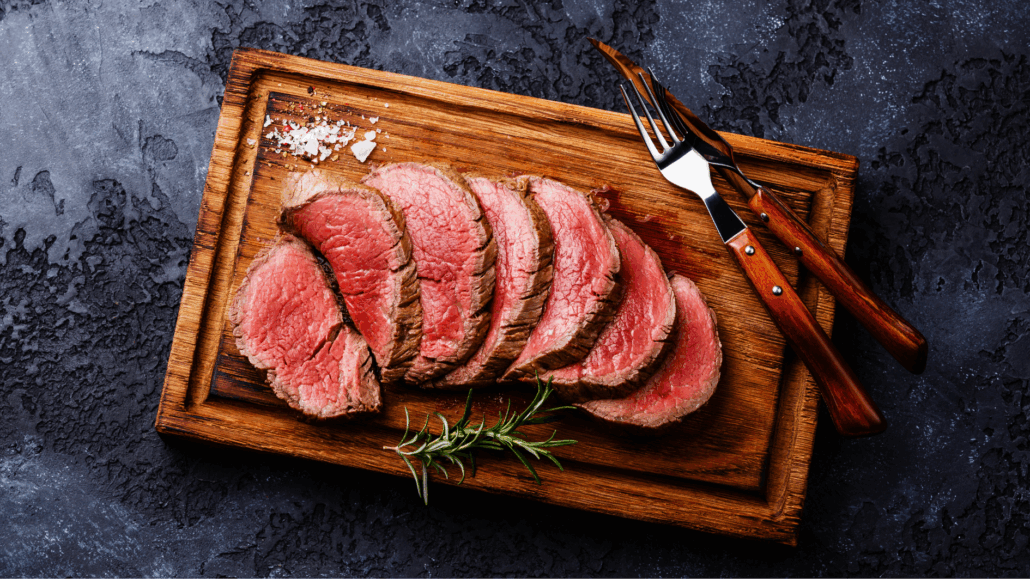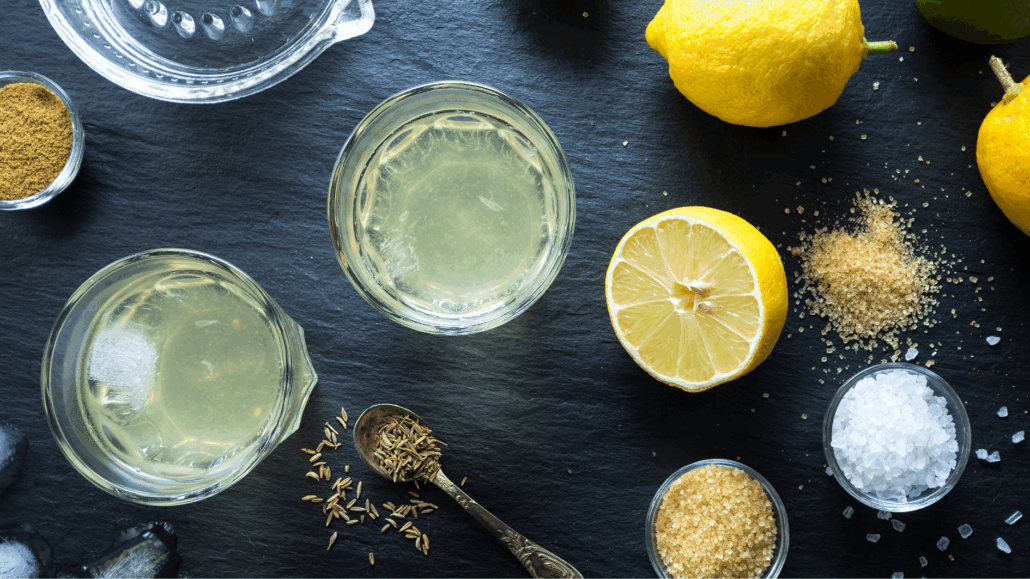We include products in articles we think are useful for our readers. If you buy products or services through links on our website, we may earn a small commission.
Paleo Diet 101: Rules and Foods
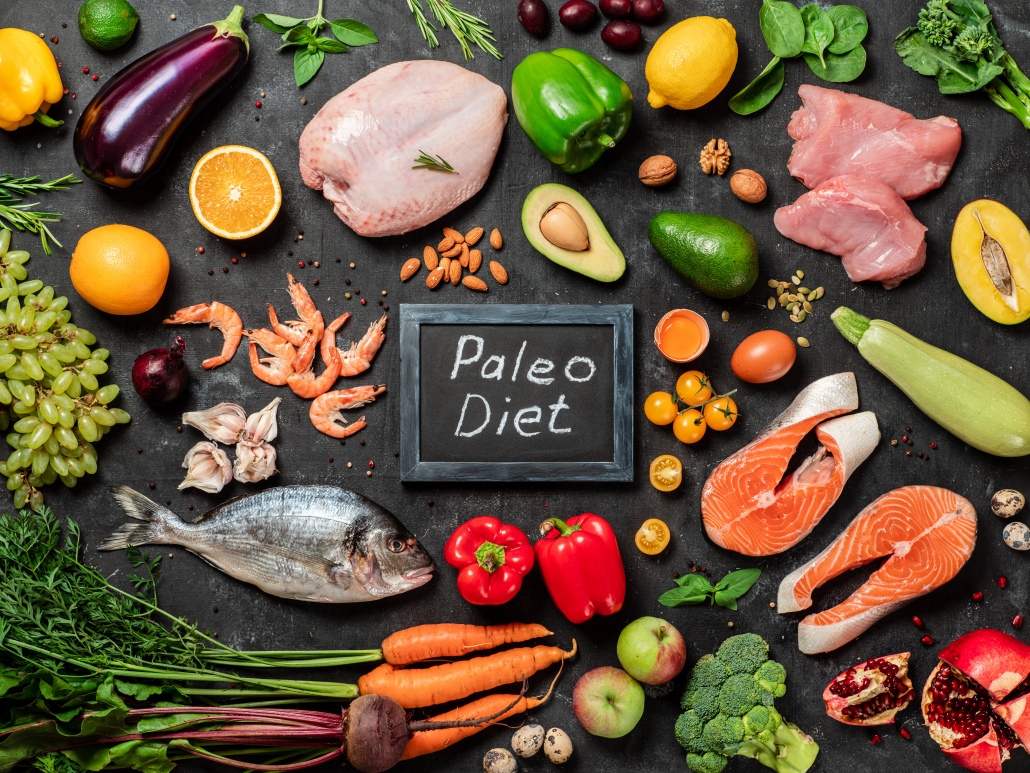
The paleo diet attempts to match the foods we eat with our evolutionarily determined nutritional needs. In other words, paleo means eating foods that the human body was designed to eat, while eliminating all other foods.
The paleo diet considers that for nearly all of the 2 million years of human evolution, agriculture and dairy did not exist. In fact, 70% of the foods we eat are products of the agricultural revolution that began only 10,000 years ago [1].
Paleo also considers modern, highly processed industrial foods, as an even more dramatic and unhealthy change from the foods that humans evolved with.
Table of Contents
Paleo Diet Definition
The paleo diet focuses on eating the types of foods presumed to have been eaten by early humans during the paleolithic era. These foods include meat, fish, vegetables, and fruit. It eliminates dairy, grains, legumes, sweeteners, and processed foods.
Origins of the Paleolithic Diet
The paleolithic diet is part of a lineage of diets seeking to recreate the eating patterns of ancient humans in modern life. “Stone Age,” “Caveman”, and Ancestral diets are all terms for variations of the paleolithic diet.
The most recent term and approach, Paleo Diet, was popularized by Colorado State University professor Loren Cordain in his best-selling book.
Tenets of The Paleo Diet
The paleo diet is based on specific tenets that are apparent in the mismatch between modern diets and ancestral diets.
Low Sugar
One of the most important elements of the paleo diet is that it is low in sugar. Eliminating all sweet foods except for fruit is an attempt to mimic eating in ancestral environments where sweet foods were extremely rare.
Diets high in sugar and carbs, like the Standard American Diet, have been shown to contribute to numerous diseases including metabolic disorder, diabetes, heart disease, osteoporosis, neurodegenerative diseases, and numerous other diseases related to chronic inflammation [1][2][3][4][5][6].
Where paleo gets it wrong: Fruit was seasonal for most ancient humans. There would have been long periods of time between relatively brief fruit harvests. Even though fruit is permitted on paleo, eating fruit regularly does not necessarily accord with ancestral eating patterns.
Nutrient Density and Ratios
The paleo diet focuses on what Dr. Cordain and associates view as the most nutrient-dense foods; fruits, vegetables, and lean meats.
For paleo adherents, legumes, potatoes, and grains are not considered vegetables and are therefore eliminated. The reasoning is that they are products of the agricultural revolution and contain various plant toxins and antinutrients that can damage human health.
Where paleo gets it wrong: Organ meats and fatty meats were likely the true primary fuel sources of ancient humans. Paleo’s substitution of fatty meats for lean meats deprives the body of the fuel and fat-soluble vitamins that were crucial to human evolution.
The paleo emphasis on lean meats aligns with outdated and faulty studies suggesting that saturated fat is associated with heart disease. However, a 2020 review of several studies shows that this association is very weak [7].
Calcium/Magnesium
The paleo diet considers that the (Ca2+)/magnesium (Mg2+) ratio in modern humans is more than twice what it should be [8]. This imbalance is due in large part to the consumption of dairy products, which have a 12:1 ratio [9].
Our bodies need magnesium to absorb calcium and to activate vitamin D. An imbalance can lead to various health issues including bone loss, skin disorders, and kidney stones, among others [10][11].
Sodium/Potassium
Paleo recognizes that the Western diet causes people to consume an imbalanced sodium (Na+)/potassium (K+) ratio.
Low potassium and high salt diets increase acidification in the body. Metabolic acidosis can contribute to bone mineral loss, cardiovascular disease, and metabolic disease [12].
For these reasons, the paleo diet dramatically reduces salt, and increases potassium-rich vegetables and fruits.
Omega-6/Omega-3 Fatty Acids
Paleo recognizes that modern food systems high in processed vegetable oils lead to an imbalance in Omega-6/Omega-3 fatty acid ratios.
Both of these fatty acids are important, and humans evolved on a diet with a ratio of roughly 1:1. Omega-6’s tend to be pro-inflammatory, while Omega-3 EFAs such as Alpha-Linoleic acid are anti-inflammatory [13].
In the modern Western diet, it’s estimated that the ratio is now around 15:1. This imbalance can result in chronic inflammation [14][15].
Meat is Essential
On the Paleo diet, meat is beneficial and essential. Taking a historical view, meat was the caloric lynchpin of human evolution–our primate brains needed meat to evolve into the human brains that define our species.
Compared with primates, the human brain requires 20% of our energy when resting. The brain of an ape requires only 8 percent [16].
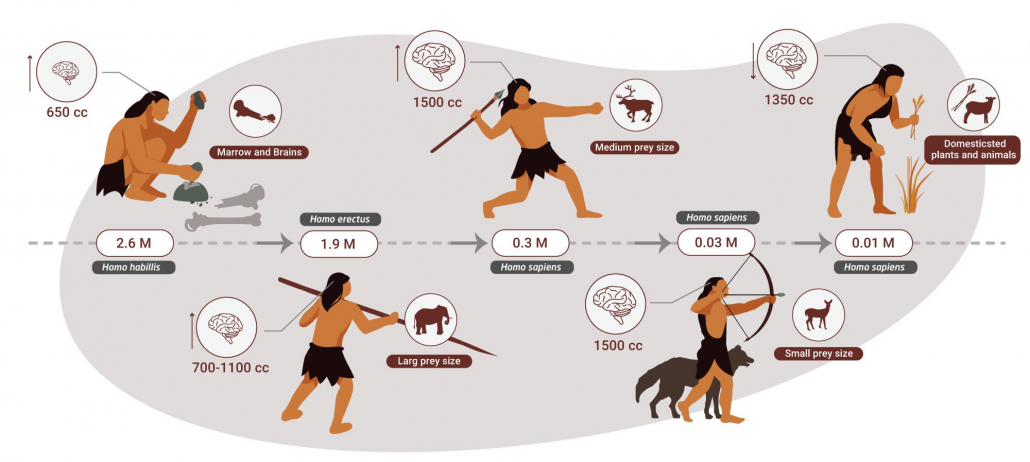
Source: Miki Ben-Dor
Paleo is about 50/50 Plant and Animal-Based
The creators of the mainstream Paleo diet state that the idea that it is primarily animal/meat-based is a misconception.
When considering caloric intake, paleo calls for obtaining about 50% of your calories from meat, and 50% from plants. However, because plants are far less calorie-dense per weight than vegetables, you end up eating significantly more vegetables by weight than meat.
For example, 6 oz. of broccoli has 58 calories, while a lean cut of steak has around 350 calories per 6 oz portion.
Doctor Cordain and colleagues derived this 50/50 plant-animal caloric split from observations of existing hunter gatherer tribes. The majority of these tribes got at least 51% of their calories from meat [17].
Where Paleo gets it wrong: Observations of modern-day hunter gatherer tribes do not accurately represent the dietary habits of Paleolithic humans.
More recent, higher-quality studies suggest that for most of the 2 million years that humans have evolved on earth, our environment teemed with large prey animals known as megafauna.
Research suggests that humans were likely hyper-carnivorous apex predators that selected for the most nutrient-dense foods available–meat [18].
Modern hunter gatherer tribes obtain their food from a much less abundant resource environment than humans evolved in. They are, therefore, forced to supplement calories from vegetables–mostly tubers and seasonal fruits.
It is also likely that the fruits and vegetables permitted on the paleo diet look and taste nothing like the uncultivated fruits and vegetables of paleolithic man.
Paleo Diet Rules
The rules of the paleo diet are intentionally flexible. There is a clear list of what you can and can’t eat, but how you formulate what you can eat into a diet plan is up to you.
Though the paleo diet deems itself as the only diet adapted to human genetics, paleolithic humans hardly ate the variety of foods promoted by the paleo diet. For instance, you would never find hunter gatherers eating a lean chicken salad drizzled with olive oil, though this is a suggested paleo diet meal [19].
Seen in this light, the paleo diet has more in common with a modified Mediterranean diet than it does with the eating habits of early humans.
In any case, let’s take a look at what paleo diet rules have to say about what to eat and what to avoid.
What to Eat on Paleo
- Lean meats, especially grass-fed animals or wild game
- Fish, especially fatty fish high in omega-3s like salmon and mackerel
- Fruits
- Vegetables (excluding potatoes and legumes)
- Nuts and seeds
- Oils from fruits and nuts, such as olive oil or walnut oil
What to Avoid on Paleo
- Grains, including wheat, oats, barely
- Legumes, including all beans, lentils, peas, and peanuts
- Pseudo grains such as chia seeds, amaranth, quinoa, and buckwheat
- All dairy products, including Butter and Ghee
- All sweeteners, including sugar, honey, stevia, and other “natural sweeteners”
- Salt
- Potatoes
- Coffee
- Processed foods in general
Paleo Diet Research
Studies looking at the effectiveness of the paleo diet for various health markers have shown generally positive results.
A 2007 study of 29 males with heart disease along with high blood sugar or type 2 diabetes compared the paleo diet with a standard Mediterranean diet.
Researchers focused on glucose tolerance, insulin levels, changes in waist circumference, and weight.
The paleo group showed significant improvement in glucose tolerance– or the speed at which glucose is cleared from the blood after a meal. The better the glucose tolerance, the lower the incidence of diabetes and metabolic disorders.
In the graphs below solid dots are baseline, open dots show results after 12 weeks. The paleo diet group is left (a), and the control group is right (b).
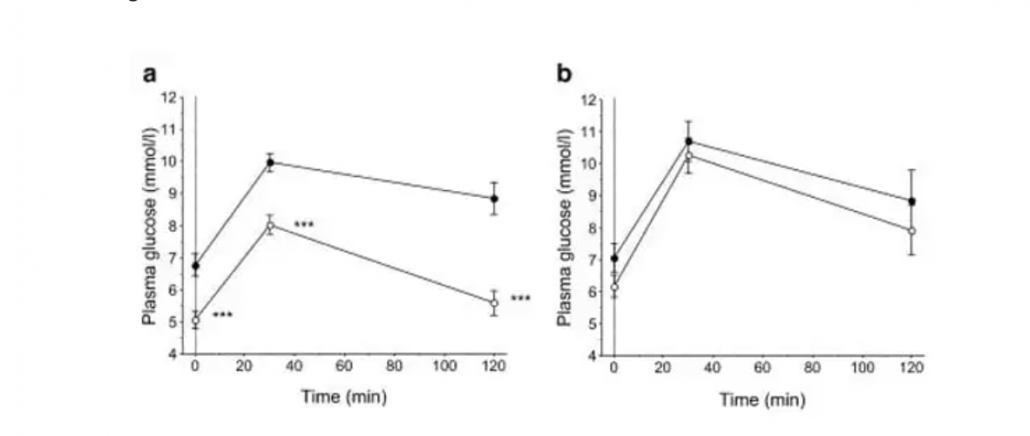
Source: Diabetologia
The group eating a paleo diet showed an average 2.2-inch reduction in waist circumference. At the same time, the Mediterranean group had a 1.1-inch average reduction [20].
A small 2008 study following 14 healthy medical students for 3 weeks found that participants lost an average of 5 bounds, and their body mass index reduced by 0.8. Waist circumference also decreased by 0.6 inches, and blood pressure decreased by 3mmHg [21].
Another small 2009 study found that participants lost an average of 6.6 pounds and more than 1.6 inches of waist circumference compared with a “diabetes diet” [22].
Other small studies show moderate to significant reductions in fasting blood sugar, “bad” LDL cholesterol, “good” HDL cholesterol, and triglycerides [23][24].
Though study outcomes were consistently, if moderately positive, they are based on very small sample sizes. More research needs to be done to confirm the efficacy of the paleo diet.
Major Critiques of the Paleo Diet
Based on what we now know about the likely diets of ancestral humans, the term “paleo” is more of a marketing term than a description of paleo foods.
The Paleolithic period runs from roughly 3.3 million years to the dawn of agriculture around 10,000 years ago. Yet the vast majority of the foods permitted on the paleo diet are products of agriculture.
Modern vegetables, fruits, and oils did not exist in the Paleolithic period. Nuts and seeds were few and far between and often required substantial processing to remove poisons. It is likely that during the Paleolithic period, humans across the globe got 55-95% of their calories from meat.
Paleo Diet: The Takeaway
The definition of the paleo diet is an attempt to eat the food that our bodies were designed by evolution to thrive on.
Paleo diet rules call for eating lean meats, vegetables, fruits, nuts and seeds. They eliminate grains, legumes, dairy, and sugars other than those that naturally occur in fruit.
However, the paleo diet does not accurately assemble the foods that humans evolved by eating for nearly 2 million years. It is much more likely that humans ate fewer fruits, vegetables, nuts, and seeds and instead got most of their calories from meat.












